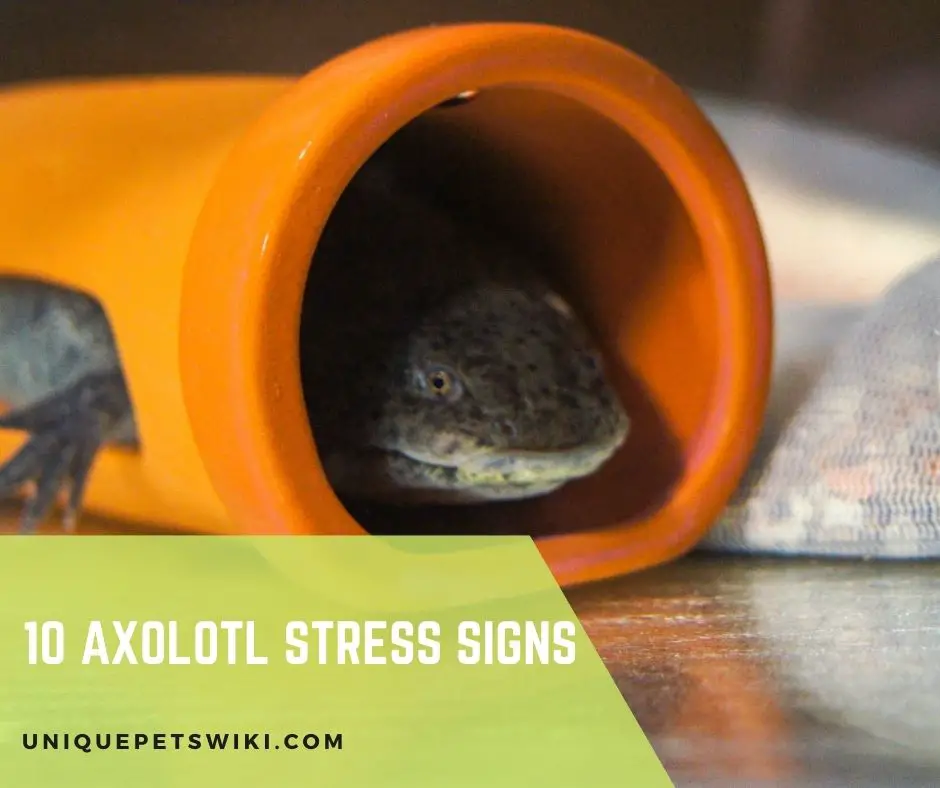You need to consider many things when taking care of axolotls – one of these is knowing that axolotls can be stressed, hence, avoiding stress at all costs.
Stress can cause many issues to your axolotl’s well-being and can even lead to death. By knowing what axolotls’ stress signs are and what factors cause this stress, you can easily prevent any issues with your axolotl.
It is always traumatic losing a pet animal to death because of something that could have been prevented or cured had there been sufficient information, and stress signs is one of the areas most keepers don’t pay attention to.
Captive-bred axolotls become stressed when one or two things are faulty in your husbandry/care.
These may include poor/incorrect water conditions, including temperature, too many other animals in the tank, dirty water, and other factors. However, dirty/contaminated water is the most likely reason.
Contents
Do Axolotls Get Stressed Easily?
Yes, Axolotls get stressed quickly. One best way to explain what happens when they get stressed is understanding the fact that axolotls are cold-blooded, which means that they depend entirely on their outside environment to survive.
Thus, a slight change in their ideal environment will cause stress to them. So what are these care-related factors that cause stress in axolotls? – they include:
- New tank or new to the environment.
- A filter that creates strong currents can cause axolotl stress.
- Inappropriate temperatures: Axolotls’ ideal temperature range is between 60 – 64 degrees Fahrenheit (16 and 18 degrees Celsius). Nonetheless, they can still do well within these temperature ranges of 50 -70 degrees Fahrenheit (10 – 20 degrees Celsius).
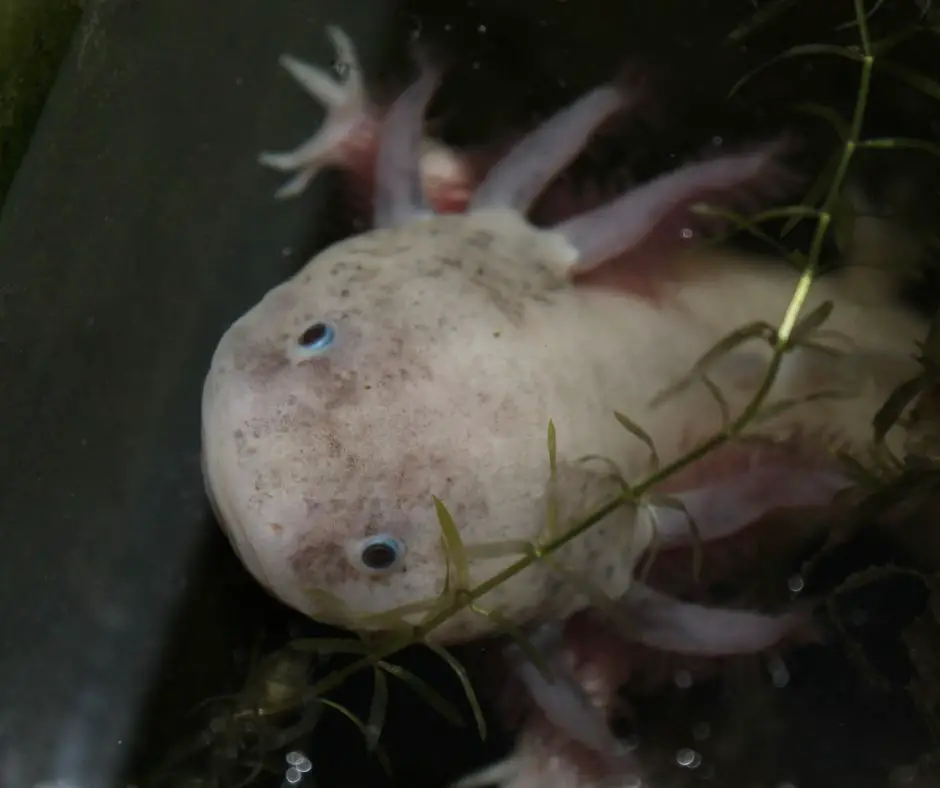
This is to say that temperatures below 50 degrees Fahrenheit and above 70 degrees Fahrenheit will cause stress. If prolonged, it can cause death.
- Poor tank maintenance: tank maintenance encompasses many things – maintaining clean water, having a working filtration system, choosing the best substrates and even tank mates are part of it.
Therefore, your pet axolotl will get stressed if:
- You fail to change the water in its tank regularly,
- Its tank lacks a healthy Nitrogen cycle,
- Its tank is overcrowded with other animals,
- The volume of water in its tank is low, or
- The water current is too strong.
- Overcrowding the tank with other living things, usually fish, fake plants, substrates such as stones, and many more.
10 Axolotl Stress Signs
Axolotl stress signs – these are symptoms, mostly behavioral, that you can use to tell that something is wrong with your axolotl or that your husbandry isn’t optimum. They include:
- Gills Curled Forward.
- Gill Deterioration.
- Curled Round Tail Tip.
- Not Eating or Loss Of Appetite.
- Frequent Going up for Air.
- Throwing Up Food/Nausea.
- Lack of responsiveness.
- Lose Pigmentation.
- Floating.
- Frantic swimming.
Let’s get into these factors in detail.
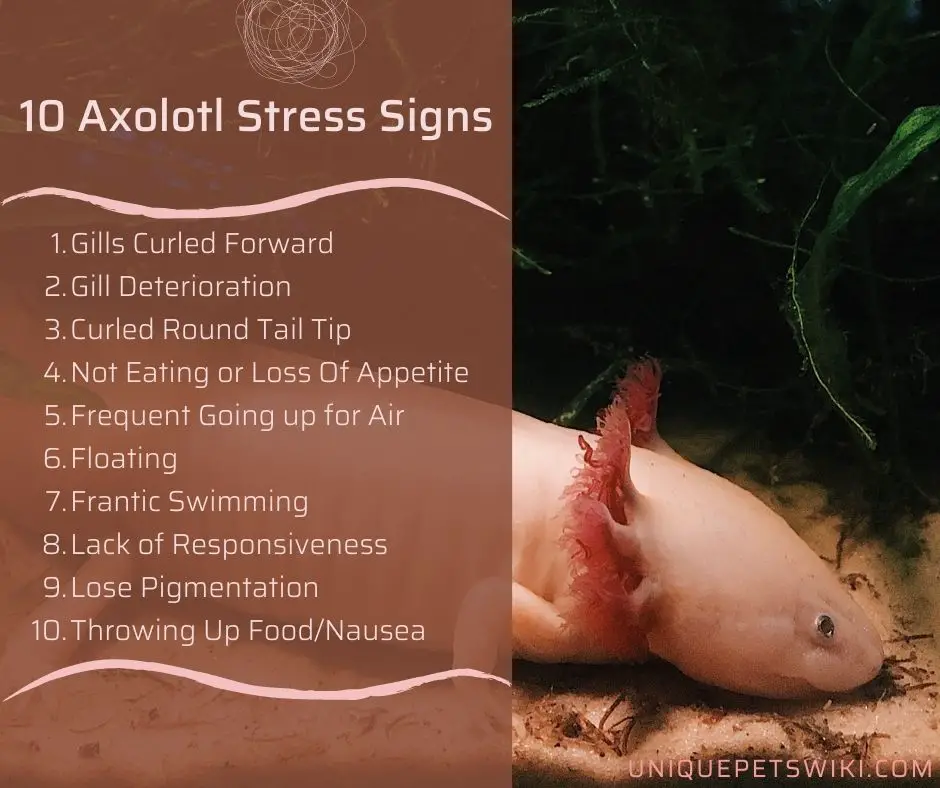
Gills Curled Forward
Gills curving outwards and towards the front of its face is often the first and most common sign of stress in axolotls. It is usually caused by wrong water parameters such as incorrect temperature, unclean water, strong current, etc.
When you notice this sign in your pet, perform a water-quality check to know which parameters are faulty and, if necessary, a water change as well.
Consult an experienced veterinarian if your axolotl’s gills remain curved despite ensuring good water quality.
Gill Deterioration
Gill deterioration often occurs due to high ammonia levels in the water. High levels of nitrate and nitrite can potentially exacerbate the problem as well.
In some cases, it could be chemical contamination in the water. In a nutshell, since poor aquarium maintenance or a lack of Nitrogen Cycle are the causes of gill deterioration, doing a water test and ensuring your tank has a healthy nitrogen cycle is important.
Going further, to prevent gill deterioration from happening, you need to do the following:
- Inculcate a regular cleaning and maintenance routine. Ideally, conduct a 25% water change every week and a complete water change every month. This will reduce the level of ammonia, nitrites, and nitrates. Keep in mind that a healthy aquarium must have very little to no ammonia and nitrites in it.
- Secondly, regularly clean your filter as this will keep the water clean.
- Also, ensure that the water parameters (temperature, current, and volume) are good.
- Maintain a healthy nitrogen cycle.
- Finally, speak to your veterinarian if you feel you aren’t doing something right.
Curled Round Tail Tip
Curling at the tip of the tail isn’t just a stress sign. Often, it’s a symptom of a more serious issue such as an illness. If this happens and you test your water parameters and nitrogen cycle to be okay, you should see your vet for a medical diagnosis.
It’s most likely that your axolotl is ill of a disease and should be treated as soon as possible by an experienced vet.
Also read: Why Are My Axolotls’ Tails Curled?
Not Eating or Loss Of Appetite
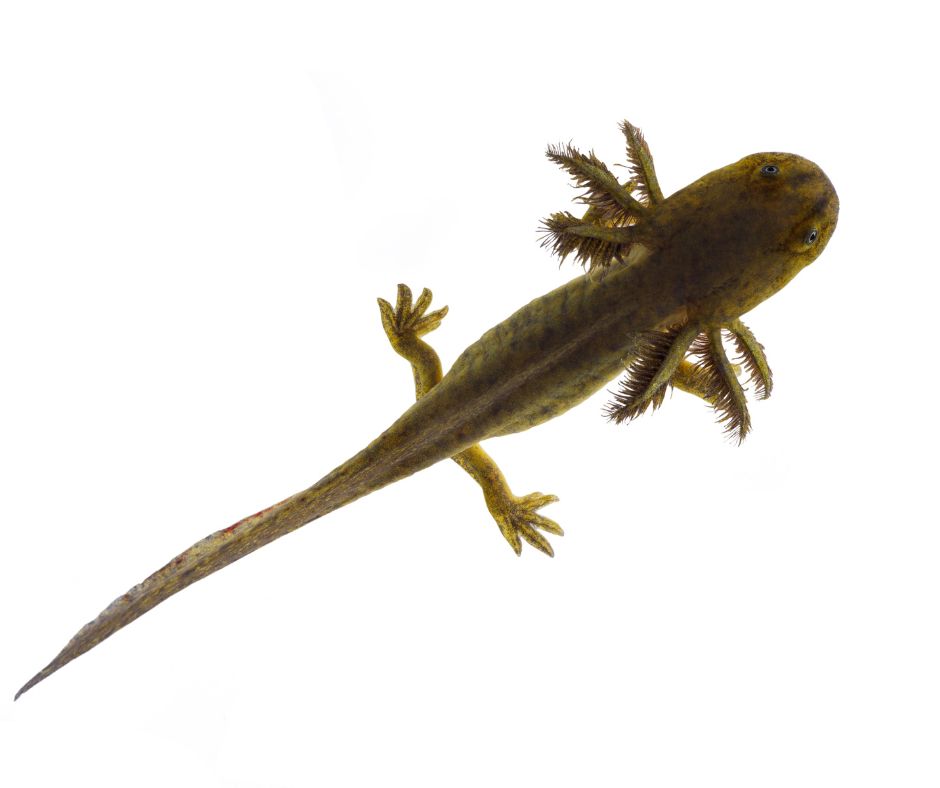
Loss of appetite is one of the first symptoms of any health issue. This means that it is not caused by one factor. So apart from stress, several other things could be responsible for why your axolotl isn’t eating.
In this case, to establish that your axolotl isn’t eating because of stress, you must check out for other signs or behavioral changes. If the loss of appetite is associated with stress, it’s likely that your water temperature isn’t optimal.
It could either be too hot or too cold or fluctuating. It could also mean that the water is contaminated or that the animal has an infection. An axolotl that has refused to eat for more than a week should be reported to the veterinarian.
Also read: Why Is My Axolotl Not Eating?
Frequent Going up for Air
Axolotls being amphibians, can breathe both air and water through the gills, lungs, and skin. Therefore, it’s common to see them swim to the surface of the water to breathe some air and return to the water.
However, if this becomes “too-frequent,” it indicates that the water is too warm and lacks some air. What you should do is to check your water temperature and adjust where necessary to the ideal levels.
The perfect tank temperature for axolotls is between 60 – 64 degrees Fahrenheit.
Floating
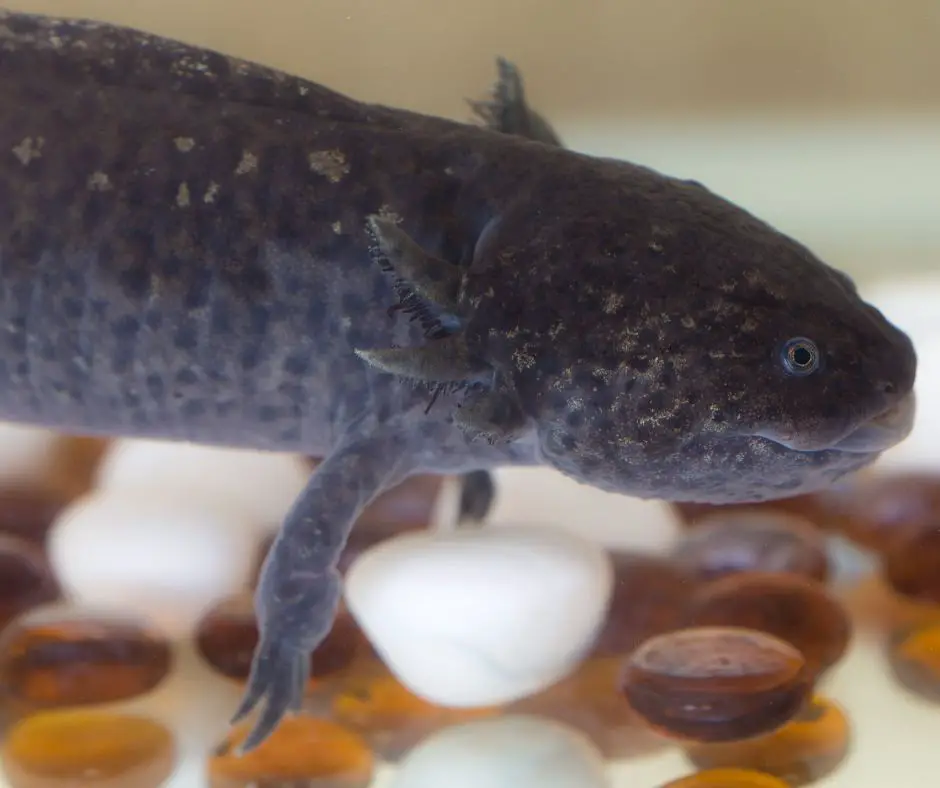
Normally, axolotls do float. Even fishes too float to relax when they aren’t hunting or exploring their environment. Floating becomes a thing of concern when your axolotl floats upside down, but it’s still alive and active.
This simply means that some air has entered its gastric system, altering its buoyancy and ability to float normally. Floating often isn’t something you can handle on your own. You should speak to your vet for medical attention.
Also read: Why Is My Axolotl Floating?
Frantic Swimming
Several things can be responsible for frantic swimming. Besides stress, high levels of ammonia, nitrates, and nitrites can be the cause.
Using contaminated water, tap water, or even too high (hot) temperatures can be the reason your axolotl is swimming frantically. Conducting a water test and generally evaluating your husbandry is often the best thing to do to address the issue.
Lack of Responsiveness
One of the signs of a stressed axolotl is a lack of responsiveness. A stressed axolotl would prefer to hide and not respond to feeding or even interaction with the owner.
As earlier discussed, this behavior is to tell you that something isn’t right in its tank. Your job is to find out what that is and correct it soon enough.
Zacro LCD Digital Aquarium Thermometer Fish Tank Water Terrarium Temperature
- Submerge probe into fish tank to measure water temperature (Submerge probe only, do not submerge thermometer in water)
- Easy to apply suction cup and easy to read LCD screen; Temperature readings to within 0.1 degree
- Large, easy to read LCD display. Compact design for discrete use
- Temperature range -50 degree Celsius~ + 70 degree Celsius; Operating temperature -10degree Celsius~ +50degree Celsius
- Powered by one LR44 button cell (included)
Last update on 2022-12-29 / Affiliate links / Images from Amazon Product Advertising API
Lose Pigmentation
Lose pigmentation can occur to the entire body or a part such as the gills. It can be a symptom of stress or blood loss due to injury. If your axolotl has no injury, then it is stress.
This often happens when they are resting. They tend to become lighter and darker, blending with the color of their environment.
Should you worry about your axolotl’s lose pigmentation? Certainly, ensure you speak to your vet about what to do.
Throwing Up Food/Nausea
Yes, stress can cause your axolotl to throw up. A very brightly lighted tank can cause this as well. Sometimes they may vomit if they have overeaten or are too cold, even if it is some hours or days afterward.
To prevent this from happening, avoid overfeeding your axolotl, do not keep it in a too bright tank, and avoid too low water temperatures.
How to Help a Stressed Axolotl
The two most effective ways of solving a problem are eradicating the root cause(s) of the problem and preventing it. In this regard, to help a stressed axolotl, you must do the following:
- Verify that your tank is cycled correctly.
- Maintain high-quality water.
- Avoid excessive handling or interaction.
- Feed an ideal diet.
- Salt bath, tea bath, or fridging.
Let’s discuss these tips in detail.
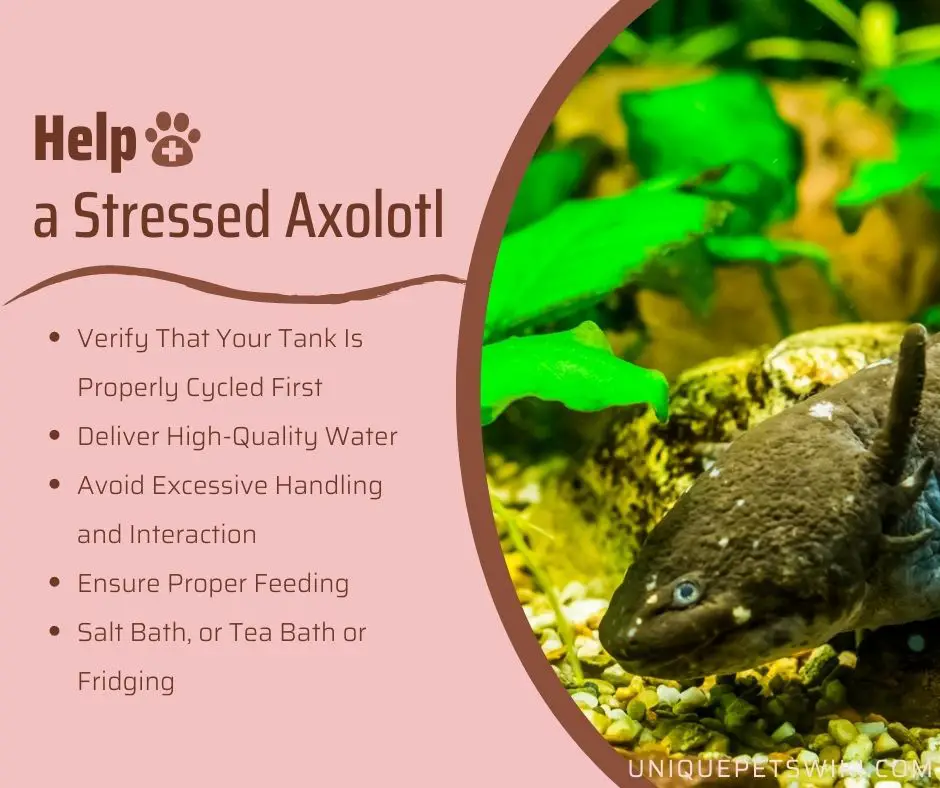
Verify That Your Tank Is Properly Cycled First
A lot of things come into play when cycling your pet’s tank. These include everything that happens in and outside the tank – from setting up a spacious habitat, checking your tank’s water parameters, filtration system, providing proper substrate to ensuring conducive temperature.
Axolotls need a spacious tank where they can roam comfortably. They also do well in slow-moving or stagnant water of about 60 – 64 degrees Fahrenheit, a sand substrate, minimal lighting, and a good filtration system to keep dirt out of the water.
Therefore, when all these are taken care of, it will reduce stress in your pet axolotls.
Deliver High-Quality Water
If you are familiar with keeping a fish, you shouldn’t have trouble maintaining high-quality water for your axolotls.
Tap water isn’t always recommended for aquatic animals as it contains high amounts of chlorine which is harmful to the animals. Nonetheless, if you should use tap water in your tank, ensure that it is treated to be chlorine-free.
Also, the importance of maintaining a steady/ideal water temperature can’t be overemphasized – allow the filter to cycle for several weeks before placing your axolotl in its new tank. This will allow the water to settle.
Finally, make sure you test the water with a water test kit on a regular basis.
API Water Test Kit
- Contains one (1) API FRESHWATER MASTER TEST KIT 800-Test Freshwater Aquarium Water Master Test Kit, including 7 bottles of testing solutions, 1 color card and 4 glass tubes with cap
- Helps monitor water quality and prevent invisible water problems that can be harmful to fish and cause fish loss
- Accurately monitors 5 most vital water parameters levels in freshwater aquariums: pH, high range pH, ammonia, nitrite, nitrate
- Designed for use in freshwater aquariums only
- Use for weekly monitoring and when water or fish problems appear
Last update on 2022-12-30 / Affiliate links / Images from Amazon Product Advertising API
Avoid Excessive Handling and Interaction
Being an aquatic pet, should you handle it at all? Axolotls do not need handling. They are so delicate with no bones. In the place of bones, they have cartilage.
For these reasons, physical handling should only be restricted to special occasions where the animal is sick and needs special medical attention.
That notwithstanding, you can interact with it while it’s in the tank. This should not cause it any stress; at the same time, avoid doing it all the time.
Ensure Proper Feeding
Feeding, you would think, shouldn’t cause stress to axolotls – yes, it’s an easy task, but when it’s not done correctly, the animal might become stressed.
Axolotls can eat both live and dead food. But giving them live foods will activate their natural hunting behavior even in captivity.
The ideal food for axolotls are those rich in protein and low in fat. These include ghost shrimp, frozen bloodworms, nightcrawlers (giant earthworms), high-quality pellet fish foods, and many more. Refer to Axolotl feeding Guide for details.
Also read: How Much Bloodworms To Feed Axolotl?
Salt Bath, or Tea Bath or Fridging
Bacteria and viruses in the water can cause stress in axolotls. If you suspect this to happen, a salt bath, tea bath, or fridging may be recommended.
Salt baths should be used together with fridging to slow down your axolotl’s metabolism and keep the mold from spreading quickly while treating it. The salt bath should be given twice a day, for 10 – 15 minutes.
To make a salt bath, mix one tablespoon of table salt with 10 gallons of water shake well till it dissolves before submerging your axolotl in the bath.
Also read:
FAQs
How to care a stressed axolotl?
Keep in mind that one of the factors that cause axolotl stress is inappropriate tank parameters – these include poor water quality, wrong water temperature, and over-exposure to light.
So if there is any light-emitting near your pet’s tank or if the tank is overlighted, ensure you provide lots of places to hide, such as plants and caves.
Also, use LED lighting to reduce the risk of stress. Ensure that the water temperature is within normal. If there was a significant fluctuation, ensure it is corrected on time.
Also read: Axolotl Temperature (Tips to Maintain an Ideal Temperature)
Why do axolotls flick their gills?
When axolotls flick their gills, they do this to create a water flow that allows more oxygen to their gills.
Why is my axolotl heaving?
As most breeders observed, heaving often happens when and after the animal has vomited. This is a heavy breathing or panting. Why your axolotl vomited can often be linked to overfeeding or stress.
Some other causes of heaving include something stuck in their mouth, an injury on the inside of the mouth, coughing, a sudden change in tank parameters, or water quality issues.
How to know if my axolotl is happy?
Axolotls can’t express emotions, but there are certain behaviors you should look out for to know if your pet is happy or not. These include:
The gills will flow freely and effortlessly with no tension.
Active movement around the tank.
Looking healthy by the color of the skin.
Eating properly.
Always coming to observe you when you approach the tank.
Generally showing high energy and activity level. (that is being active).
In Conclusion
Axolotls are so easy to take care of but still have some basic requirements that need to be met to have a stress-free life.
These requirements include a large tank to swim and eat, ideal food, a large volume of dechlorinated water, a good water filter, and a proper water temperature.
So when you are thinking about getting a pet axolotl, always be sure to follow these basic requirements for a stress-free life for your pet.
You should keep in mind that axolotls, like all amphibians, are sensitive to poor living conditions and poor water quality.
Therefore, once you notice any of the stress signs discussed in this article, you need to evaluate your care and make changes to their environment where necessary.
Of all the stress signs discussed earlier, many of them can be treated by testing and adjusting your water parameters accordingly. Always check your water and make sure your tank is properly cycled before treating your axolotl if it appears sick or stressed.
